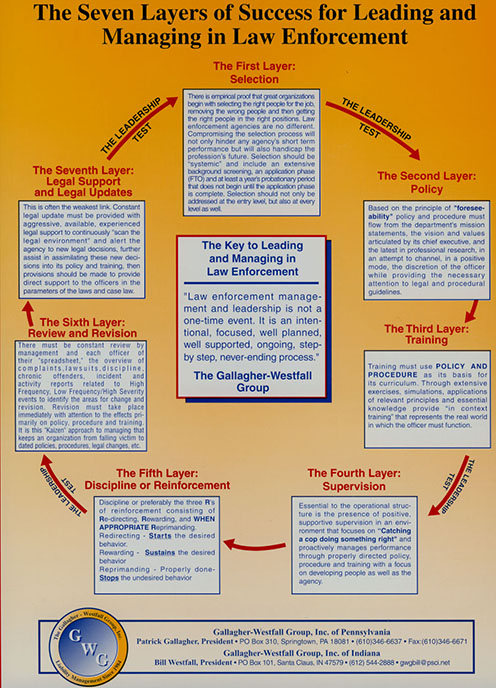Resources: The Seven Layers of Success©
Pat Gallagher created The Institute for Liability Management in 1984. While most of the profession was in disarray and frustrated over this paradigm shift of liability that accompanied the U. S. Supreme Court Monell decision in 1978, he was a visionary who understood that liability would be the means by which to leverage the profession to improve and change. Mr. Gallagher understood a simple concept that has existed since the era of Sun Tzu, that a well-lead, supervised and managed organization will maximize its performance standards while minimizing the liability threat.
After focused research and discussion with both plaintiff’s attorneys as well respected police defense attorneys, Mr. Gallagher created what he called The Six Layers of Liability Protection©. There was nothing new within the Six Layers of Protection to any agency which had focused on improvement. The six components of policy, training, supervision, discipline or the three r’s of redirection, reward and reprimand, review and revision and legal updates are at the heart of the quality movement and the principles are timeless. Mr. Gallagher’s understanding went well beyond them simply be a component of an agency or being present, but he pioneered the thought that they must be integrated one with the other, supporting one another and must be constantly improved, never done, in a constant state of flux of as the quality literature would say, exist within “kaizen.” Mr. Gallagher’s recently published book Successful Police Risk Management, 2014 focuses on an explanation and means by which to properly implement his liability concepts.
I had the good fortune to join Pat Gallagher in 1988 and work with him for four years teaching and developing and hopefully improving liability management and prevention concepts for public safety agencies nationwide. We did so together within the ILM working for an insurance brokerage firm who had a number of public sector clients. In 1992, Mr. Gallagher and I formed The Gallagher-Westfall Group, Inc. as an intellectual partnership with separate corporations and remain such to this day.
When I joined Pat, the interest that I brought to the table was how leadership/management/supervisory skill sets impacted organizational behavior and performance. Pat, ever the mentor and teacher, was kind enough to give me full license to change any and all curriculum that he had developed. As a result, in time, the Six Layers of Protection© for Managing Liability evolved within my own corporation to the Seven Layers of Success© for Leading and Managing in Law Enforcement to include The Leadership Test©. The seventh layer of selection was added due to the influence of the work of Dr. Jim Collins and Good To Great. His argument, that so many performance, quality, retention and motivational issues are simply minimized if not eliminated, with good selection resonated. It is just too important to simply assume.
The Seven Layers of Success for Leading and Managing in Law Enforcement© is the basis for every training program that GWG of Indiana provides. So, whether it is a one-day introduction session or all four phases of The Leadership/Management and Mastering Performance in Law Enforcement series, The Seven Layers of Success© is the focal point and becomes a tool that a police officer, a supervisor, a chief, a sheriff or a risk manager can use and can use in any function within the department whether, patrol, training, investigation, crime scene units. It simply works. It works anywhere. We have had insurance pools we have worked with adapt it for their roads, water works, recreation entities, not just their police agencies and have seen liability exposures reduced dramatically. It even works at Cracker Barrel. Did you ever wonder why the syrup is always “hot” in over 600 Cracker Barrel’s nationwide? The hire good people, they write and implement procedures, they train to those procedures, they supervise that training and those procedures, they redirect, reward (Have you ever notice the stars on their aprons which are always neat and clean?) and reprimand when necessary. And then they constantly review to improve those standards and procedures which are never done.

Download this artice: PDF Format
